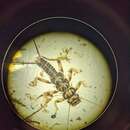Conservation Status
provided by University of Alberta Museums
The species is not endangered, but as with all stoneflies, it is sensitive to organic pollution.
- license
- cc-by-nc
- copyright
- University of Alberta Museums
Cyclicity
provided by University of Alberta Museums
Adults emerge in early to mid July depending on water temperatures.
- license
- cc-by-nc
- copyright
- University of Alberta Museums
Distribution
provided by University of Alberta Museums
In Alberta, the species is known from boreal streams. In North America, it occurs from northern Quebec south through New England to Florida and west to Ontario, Manitoba, Saskatchewan, and Tennessee.
- license
- cc-by-nc
- copyright
- University of Alberta Museums
General Description
provided by University of Alberta Museums
Males (length = 18 mm) have paraprocts that are flattened, triangular and sharply pointed at their anteriorly directed tips, and have spinules on Tergites 9 and 10. Females (length = 35 mm) have the subgenital plate produced and flattened or emarginate apically. Adults can be distinguished from Acroneuria abnormis by the presence of anal gill remnants and dark brown sclerotization on the head within the ocellar triangle. Nymphs have anal gills, and a banded pattern on abdominal terga with a light M-pattern in front of the anterior ocellus.
- license
- cc-by-nc
- copyright
- University of Alberta Museums
Habitat
provided by University of Alberta Museums
Large, cool water streams and rivers.
- license
- cc-by-nc
- copyright
- University of Alberta Museums
Life Cycle
provided by University of Alberta Museums
The life cycle is three years in Saskatchewan, and the nymphal habitat is under larger rocks in regions of the stream with the swiftest current.
- license
- cc-by-nc
- copyright
- University of Alberta Museums
Trophic Strategy
provided by University of Alberta Museums
Nymphs are carnivorous, preying on other smaller aquatic insect nymphs and larvae.
- license
- cc-by-nc
- copyright
- University of Alberta Museums
Acroneuria lycorias
provided by wikipedia EN
- license
- cc-by-sa-3.0
- copyright
- Wikipedia authors and editors
Acroneuria lycorias: Brief Summary
provided by wikipedia EN
Acroneuria lycorias or the boreal stonefly is a species of stonefly native to North America. It was first described by Edward Newman in 1839. The species is named after the Nereid Lycorias of Greek mythology.
The species is found in North America. It ranges from northern Quebec southwards through New England to Florida and westwards to Ontario, Manitoba, Saskatchewan, and Tennessee. In Alberta, the species is known from boreal streams. The insect frequents large cold water bodies and has a life cycle of three years. The nymphs are aquatic and carnivorous. While large stoneflies are not endangered, like all stoneflies, they are very sensitive to pollution.
- license
- cc-by-sa-3.0
- copyright
- Wikipedia authors and editors

